| 1 | Mexico’s deadly cottonmouth relative |
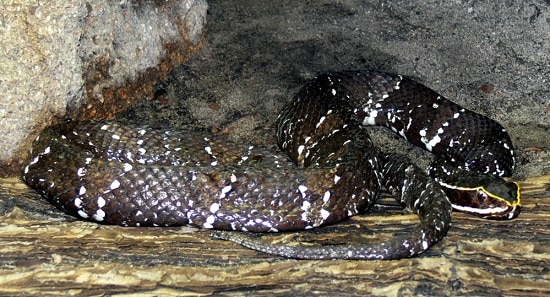
In Mexico, it sometimes feels like there’s a venomous snake waiting around every corner. In jungles, there’s red and yellow coral snakes waiting patiently. In wide sweeping grasslands, there’s aggressive rattlesnakes hissing at you. Even if you take refuge inbetween, you’re likely to meet the greatest terror of all: the Mexican cantil (Agkistrodon bilineatus).
This is a stubby species averaging at 60-80cm (max 138cm), which belongs to the same Agkistrodon genus as cottonmouths and copperheads. Its territory begins in middle Mexico, and spreads southwards through Guatemala, Honduras, and Nicaragua. Rather than rainforests, they prefer drier forests, including tropical deciduous forests and dry thorn scrubland, perhaps straying to grassland if there’s plenty of bushy shelter.
Mexican cantil venom lacks neurotoxins, with no paralysing powers like a coral snake. Its speciality is haemorrhaging, with a side order of swelling and tissue destruction, and several deaths have been recorded.
The LD50 rating is 0.8mg, which easily outstrips its cousins the cottonmouth (2.04mg) and copperhead (10.9mg). Opinions differ on its temperament – some say they’re thuggish and aggressive, while others say they’re calm unless provoked. Nevertheless, the word “irritable” pops up in a huge amount of reports. The Mexican cantil is a snake you’ll want to avoid.
| 2 | Lightning fast lunges |
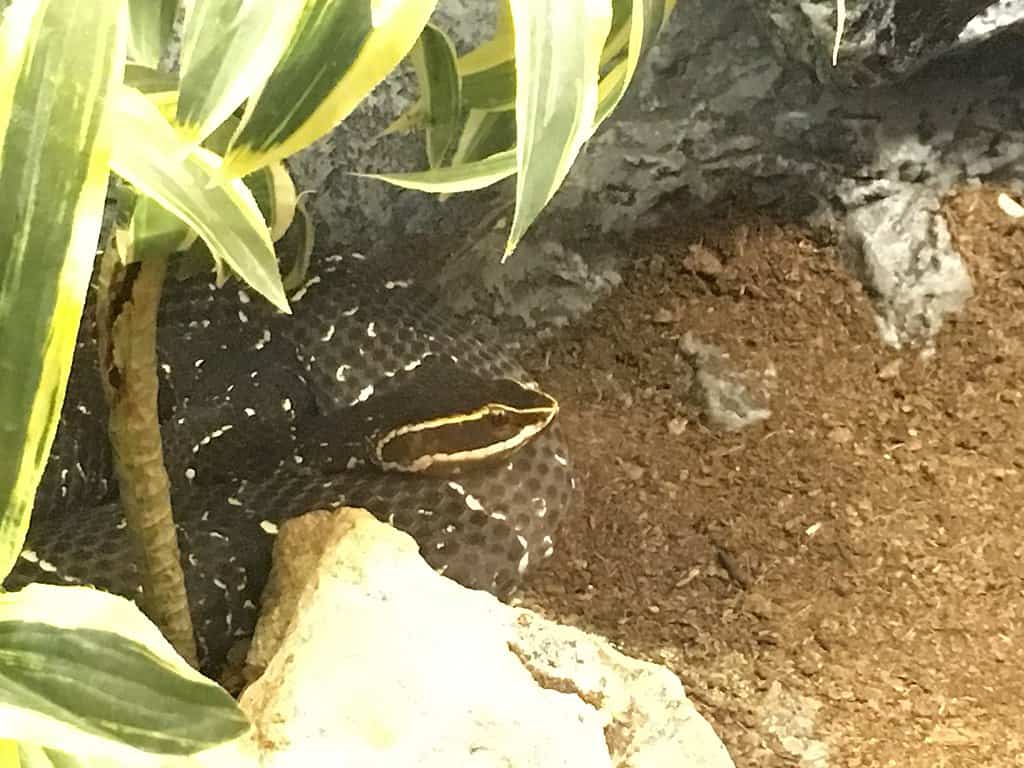
Mexican cantils particularly like dry tropical forests in foothills, usually below 600 metres above sea level and never exceeding 1500 metres. They’re a common sight on dusty roads through the middle of dry forests, with an abundance of thorny bushes on either side. Mexican cantils like to hide in undergrowth, or in rock piles. Though a lover of dry areas, they’re also decent swimmers. They’ll enter a pool instantly rather than being wracked by indecision. Mexican cantils climb trees, but only occasionally.
Mexican cantils are far from active like a cobra, zooming around the countryside. They’re fairly sluggish, lurking in thorny bushes. Yet they only require a slight provocation to turn defensive. If it senses any danger, a Mexican cantil will coil rapidly into an S-shape, with their head slightly above the ground. They’ll poke out their tongue and move it steadily up and down, while maintaining a menacing glare.
Then they’ll produce several lightning fast lunges without warning, with an open mouth and sharp fangs bared. This is a snake which hates being disturbed, even if they’re seemingly doing nothing.
| 3 | Vividly black and white |
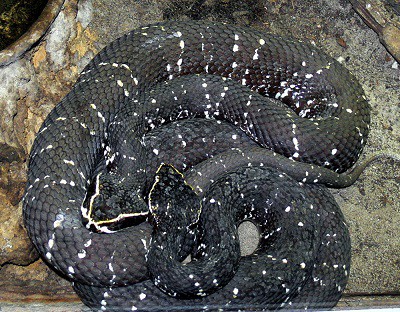
Agkistrodon bilineatus is closely related to cottonmouths and copperheads, yet nobody could ever confuse them. Their body is like a starry midnight sky – pitch black with occasional bright white shining through. Their dark body makes their eyes very difficult to see, but they have sharply vertical pupils.
On their face, the white becomes more organised into a pair of lines above the jaw, and another pair above the eye. Then there’s the snout – there’s sometimes a strange white symbol like a bird in flight, spreading its wings (see above). One of their nicknames is Mexican yellow-lipped viper. In fact, cantil derives from the Tzeltal word for “yellow lip”.
Mexican cantils have a very triangular head when viewed from above, with a pointy snout. Any bird that witnesses this triangle knows it has a tough task on its hands, with one piercing fang resulting in a fatal venom injection. Triangular heads are an instant signal of danger for snakes, so much so that some harmless snakes mimic them deliberately.
| 4 | A unique toxin (Bilitoxin) |
They might be related to cottonmouths, but Agkistrodon bilineatus has a venom profile which has spiralled in deadly new directions, since they made the fateful decision to head to Mexico. In 2000, a study revealed that the Mexican cantil is especially rich in a haemorrhagic toxin called Bilitoxin-1. This strongly inhibits thrombin, a proper ingredient of healthily clotting blood.
In a healthy human, thrombin converts the raw material fibrinogen into fibrin, which itself leads to clotting that seals wounds (not deep vein clotting). Bilitoxin-1 also has proteolytic properties – it destroys the structure of proteins by cleaving through amino acid bonds. The result is the destruction of skin tissue. This is a toxin with multiple dangers. Mexican cantil venom contains 15.3% bilitoxin-1 overall, just slightly less than its Mexican neighbours – the Yucatecan cantil (16.8%) and Taylor’s cantil (17.5%).
A 2019 study used a Minimum Haemorrhagic Threshold – defined as the minimum quantity of a toxin required to cause a haemorrhaging halo with a diameter of 1cm. Bilitoxin-1 was incredibly powerful, scoring 0.008ug.
| 5 | Eats a varied diet |
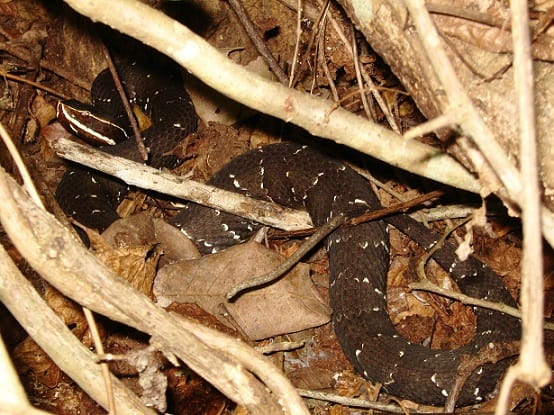
The Mexican cantil’s stomach is a bottomless black hole that will eat pretty much anything. They don’t have a digestive system specially designed for tree frogs, they have digestive system specialised for food.
Living in tropical deciduous forest and dry thorn scrub, they have the best of both worlds. They can suck in rodents which stride open plains, and lizards in the cores of forests which stray to their edges. Mexican cantils also dine on fellow snakes, including the Central American tree snake (Imantodes gemmistratus). This is a branch lover measuring 90cm, which likes drier forests, just like the cantil.
Other prey include clouded anoles, western spiny-tailed iguanas, rice rats (Oryzomys palustris), and pocket mice. One absentee from the official list is human beings, but rest assured that this is only because they’re too small. Mexican cantils also eat reptile eggs, according to a 2021 report from Colima, Mexico, and there’s doubtlessly more fellow snakes they eat in secret.
| 6 | But opossums are immune |
No matter how hard a cantil bites, there’s one furry creature it cannot defeat: the Virginia opossum. This mammal trots around the American and Mexican countryside at a leisurely pace, as it knows that it’s immune to the majority of local snake venoms. A 1976 study used 12 snake species, and injected Virginia opossums with 4-60 times the usual fatal dose in similarly sized mammals. Some were even put in an arena with the snake and bitten. A handful of opossums were reinjected with venom 40-90 minutes after the first dose. As well as Mexican cantils, the study involved:
- Both eastern and western diamondback rattlesnakes.
- Both the cottonmouth and copperhead.
- The Korean mamushi (Gloydius brevicauda).
The Virginia opossums not only survived all of these snake venoms, but experienced no symptoms, such as haemorrhaging or necrosis. Like the others, Mexican cantil venom simply bounced off them.
The immunity definitely had a local bias. Puff adder venom from African led to death, as did cape cobra and Indian cobra venom. Nevertheless, Virginia opossums lives nowhere near those animals, so it’s a creature of efficiency. This is the one animal that might have a Mexican cantil doubting itself. Without speed on its side, the Virginia opossum had to evolve alternative defences, and venom resistance was a smart choice.
| 7 | Deadlier than its American cousins |
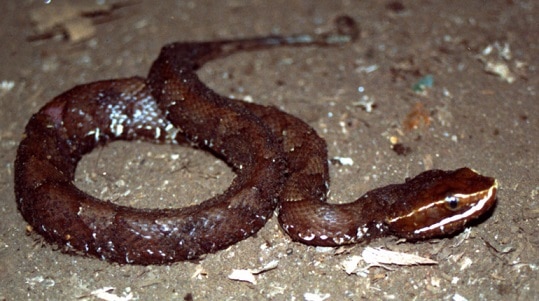
Mexican cantils also have a strong though not colossal venom yield – 50-95mg per bite. At 80-170mg, a cottonmouth’s yield is significantly higher, although the venom itself is less potent. Meanwhile, a 2013 study found that Mexican cantils had the highest myotoxic activity of the Agkistrodon family – toxins that target muscle tissue. They also had the highest haemorrhagic activity, while copperheads had the lowest. A 2019 study examined swelling (oedema), and again, Mexican cantils were far more dangerous than copperheads or cottonmouths. Their cousins the Yucatecan and Taylor’s cantil were equally dangerous.
This study also found that the toxin profile of Mexican cantil venom barely varies across its range. Snakes were collected from the states of Chiapas (extreme south), Colima (southwest), and Nayarit (mid-west). This isn’t always true – Mojave rattlesnakes are missing their usual neurotoxins in certain regions.
Mexican cantils are nocturnal and their black colours are optimal for blending with night, just as a copperhead’s colours blend perfectly with leafy forests floors.
| 8 | Actual bite reports |
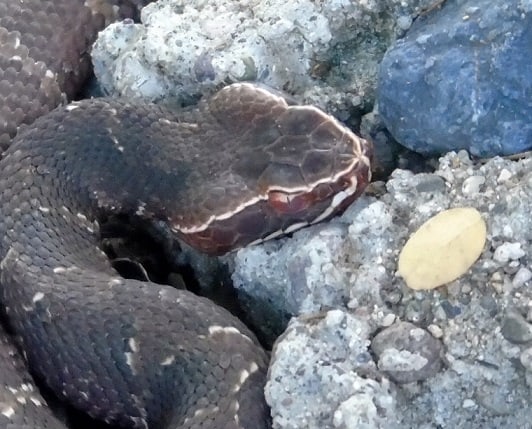
One bite happened to a zoologist in the UK, who was bitten on the index finger by a Mexican cantil in his home. He instantly developed a blood blister, but no other symptoms. 15 hours later, a wave of swelling appeared which reached the armpit. The zoologist reached the hospital, and 26 hours post bite he was administered 8 vials of Polyvalent Crotalinae Antivenom. 4 days post bite, he was deemed fit for discharge, but on day 5, he suddenly developed lip swelling, hoarseness, fever, and a rash spreading across his torso and face. He was readmitted to hospital for the night, and administered adrenaline and hydrocortisone.
Another case involved a 39 year old herpetologist, who was bitten by a Mexican cantil on the right hand in his workplace. He reached the emergency department after 19 hours, and was experiencing necrosis and swelling all the way to his torso. He showed evidence of rhabdomyolysis, when muscle tissue dies and releases its components like myoglobin and electrolytes into the bloodstream, which can even trigger death. Doctors frantically sought antivenom abroad, eventually importing it within 12 hours. 32 hours post bite, the man received several vials. He also received skin grafts, and survived, but 3 months post bite, he still had difficulty moving the fingers of his right hand.
| 9 | Their habitats are declining |
As a juvenile, Agkistrodon bilineatus is a tail waggling species, a snake that uses caudal luring: when they lure in prey with a bright yellow tail tip. They writhe this to resemble an earthworm wriggling around, which is irresistible for some animals. In 1949, a captive Mexican cantil successfully lured a tree frog, an oak toad and an anole using this strategy. After the cantil ate, it kept its tail down for 2 days. Adults also have a whitish tail, and it’s believed that they keep the caudal luring skill with age (unlike some snakes).
Mexican cantils lay 8-20 newborns. They begin life as a lighter brick red colour, which gradually darkens until achieving the stony grey or pitch blackness of adulthood. In captivity, Mexican cantils can exceed 20 years.
Mexican cantils aren’t endangered, yet are significantly less common than they used to be. Rainforests are protected, but drier thorn forests not so much, and these have been slashed down steadily for agriculture. A survey from the Mesoamerica Pacific coast found that just 0.09% of tropical dry forests were protected.
| 10 | The cantil family tree |
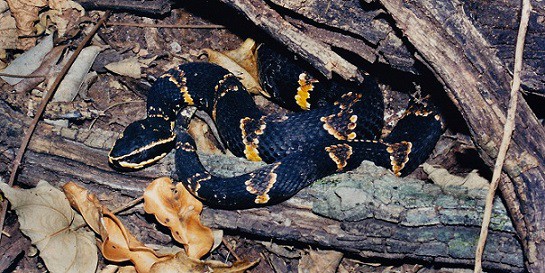
The Mexican cantil has gradually been split into several independent species. The following three were all originally subspecies:
Taylor’s cantil (Agkistrodon taylori) – a resident of northeast Mexico, not quite reaching the US border. This is particularly sought after by reptile keepers for its striking black gold patterns. Its lip line is also thicker.
Southern cantil – AKA Agkistrodon howardgloydi. Native to Costa Rica and Panama, and similar in its love for dry, thorny forests. The southernmost member of the family.
Yucatecan cantil (Agkistrodon russeolus) – this has a small territory, being native to Mexico’s Yucatan peninsula, and Belize next door. Generally has a reddish colour rather than pitch black.
The Mexican cantil overlaps with neither of its US relatives. Cottonmouths are confined to southern US swamps, while broad-banded copperheads just reach extreme northern Mexico, but the Mexican cantil begins in central Mexico.
